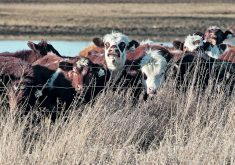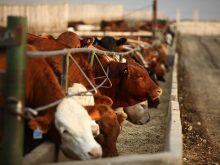Compared to last week, western Canadian feeder cattle markets traded $2 lower to $4 higher on average. Many auction barns were on holidays last week; therefore, the buying interest appeared to be more concentrated on the major markets. There were no reports from Manitoba last week.
Alberta packers were buying fed cattle on a dressed basis in the range of $306-$307/cwt delivered, up $2-$3 from seven days earlier. U.S. packer interest was also noted in southern Alberta, with bids of $187-$188 f.o.b. the feedlot. Feedlots are becoming more current with production and year-end buying contributed to the firmer tone. The quality of cattle was quite variable last week. The major feeding regions of Alberta have been contending with excessive snow and colder temperatures which set a premium for pre-conditioned or vaccinated calves. Yearlings were also well bid with April 2023 live cattle futures reaching fresh contract highs over $161. It’s important to draw attention to the April 2024 live cattle futures which bounced back up above $167. The all-time high is $172, which occurred during the first week of October back in 2014. The bullish outlook for live cattle has kept nearby feeder prices well supported.
Read Also

Huge crops in South America says analyst
Although there’s a debate over the size of the South American soybean crop, there’s little doubt that it will be an enormous one, said consultant Michael Cordonnier of Soybean and Corn Advisor in Hinsdale, Ill.
In central Alberta, a sizeable group of larger-frame, medium- to lower-flesh mixed steers weighing just under 900 lbs. dropped gavel at $233; mixed heifers of similar quality averaging 860 lbs. sold for $220. In central Saskatchewan, medium- to larger-frame black mixed steers scaling at 920 lbs. were quoted at $226. The steer-heifer spread appeared to be wider in Saskatchewan last week but the limited numbers made the market hard to define. Southeast of Calgary, a small group of heifers hovering at 910 lbs. were valued at $216.
South of Edmonton, a small group of Angus-blended steers with full health data on forage diet weighing 712 lbs. were notched the charts at $257. In southern Alberta, semi-weaned tan steers averaging 630 lbs. were valued at $270 and Charolais-based heifers scaling at 650 lbs. were quoted at $226. In central Saskatchewan, mixed semi-weaned steers weighing just over 600 lbs. reached up to $275.
At Beaverlodge, Alta., black steer calves weighing 464 lbs. stopped short at the $299 mark; however, south of Edmonton, mixed steers weighing 473 lbs. reached up to $315. Strong demand surfaced for lighter calves; buyers were content purchasing smaller packages to build up a load.
Placements on the U.S. Department of Agriculture’s Cattle on Feed report were higher than anticipated. Placements during November in the heavier weight categories were similar to last year. Placements under 700 lbs. were down more significantly. This may be neutral for nearby feeder cattle prices but slightly bullish for the spring feeder market.
— Jerry Klassen is president and founder of Resilient Capital, specializing in proprietary commodity futures trading and market analysis. Jerry consults with feedlots on risk management and writes a weekly cattle market commentary. He can be reached at 204-504-8339 or via his website at ResilCapital.com.
















